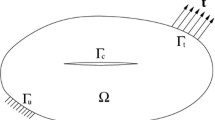Abstract
This paper extends to three dimensions (3D), the computational technique developed by the authors in 2D for predicting the onset and evolution of fracture in a finite element mesh in a simple manner based on combining the finite element method and the discrete element method (DEM) approach (Zárate and Oñate in Comput Part Mech 2(3):301–314, 2015). Once a crack is detected at an element edge, discrete elements are generated at the adjacent element vertexes and a simple DEM mechanism is considered in order to follow the evolution of the crack. The combination of the DEM with simple four-noded linear tetrahedron elements correctly captures the onset of fracture and its evolution, as shown in several 3D examples of application.















Similar content being viewed by others
References
Astm standard d638-10 (2003) Standard test method for tensile properties of plastics. ASTM international, West Conshohocken, PA. https://doi.org/10.1520/d0638-10, www.astm.org
Carneiro FLLB (1943) A new method to determine the tensile strength of concrete. In: Proceedings of the 5th meeting of the Brazilian association for technical rules, pp 126–129 (in portuguese)
Cervera M, Chiumenti M, Agelet de Saracibar C (2004) Shear band localization via local \(\text{ J }_{2}\) continuum damage mechanics. Comput Methods Appl Mech Eng 193:849–880
Cervera M, Chiumenti M, Codina R (2010) Mixed stabilized finite element methods in nonlinear solid mechanics part I: formulation. Comput Methods Appl Mech Eng 199:2559–2570
Cervera M, Chiumenti M, Codina R (2010) Mixed stabilized finite element methods in nonlinear solid mechanics part II: strain localization. Comput Methods Appl Mech Eng 199:2571–2589
Cervera M, Chiumenti M, Codina R (2011) Mesh objective modelling of cracks using continuous linear strain and displacements interpolations. Int J Numer Methods Eng 87:962–987
Cundall PA, Strack ODL (1979) A discrete numerical model for granular assemblies. Geotechnique 29(1):47–65
Ground accelerogram from el-centro, imperial valley irrigation district (comp s00e). http://www.eng.ucy.ac.cy/petros/earthquakes/eq1.txt
Johnson PR, Petrinic N, Sli E (2005) Element-splitting for simulation of fracture in 3D solid continua. In: VIII International conference on computational plasticity, Barcelona
Katagiri S, Takada S (2002–03) Development of FEM–DEM combined method for fracture analysis of a continuous media. Memoirs of the Graduate School of Science and Technology, Kobe University Japan, vol 20A, pp 65–79
Labra C (2012) Advances in the development of the discrete element method for excavation processes. Ph.D. thesis, Barcelona
Labra C, Oñate E (2009) High-density sphere packing for discrete element method simulations. Commun Numer Methods Eng 25(7):837–849
Lopez J, Oller S, Oñate E, Lubliner J (1999) A homogeneous constitutive model for masonry. Int J Numer Methods Eng 46:1651–1671
Luong M (1990) Tensile and shear strengths of concrete and rock. Eng Fract Mech 1–3(35):127–135
Mishnaevsky L Jr, Lippmann N, Schmauder S (2003) Computational modelling of crack propagation in real microstructures of steels and virtual testing of artificially designed materials. Int J Fract 120:581–600
Munjiza A (2004) The combined finite-discrete element method. Wiley, New York. ISBN: 0-470-84199-0
Oñate E, Labra C, Zárate F, Rojek J, Miquel J (2005) Avances en el desarrollo de los métodos de elementos discretos y de elementos finitos para el análisis de problemas de fractura. Anales de Mecánica de la Fractura 22:27–34
Oñate E, Zárate F, Celigueta MA, González JM, Miquel J, Carbonell JM, Arrufat F, Latorre S, Santasusana M (2017) Advances in the DEM and coupled DEM and FEM techniques in non linear solid mechanics. In: Oñate E et al (eds) Advances in computational plasticity. Springer, Berlin
Oñate E, Zárate F, Miquel J, Santasusana M, Celigueta MA, Arrufat F, Gandijota R, Valiullin K, Ring L (2015) A local constitutive model for the discrete element method application to geomaterials and concrete. Comput Part Mech 2:139–160
Rojek J, Oñate E, Zarate F, Miquel J (2001) Modelling of rock, soil and granular materials using spherical elements. In: 2nd European conference on computational mechanics ECCM-2001, Cracow, 26–29 June 2001
Shmauder S, Wulf J, Fischmeister HF (1993) Finite element modelling of crack propagation in ductile fracture. Comput Mater Sci 1:297–301
Williams J, O’Connor R (1999) Discrete element simulation and contact problem. Arch Comput Methods Eng 6(4):279–304
Zárate F, Oñate E (2015) A simple FEM-DEM technique for fracture prediction in materials and structures. Comput Part Mech 2(3):301–314
Zienkiewicz OC, Zhu JZ (1992) The superconvergent patch recovery (SPR) and adaptive finite element refinement. Comput Methods Appl Mech Eng 101:207–224
Acknowledgements
This work was partially supported by the ICEBREAKER Proof of concept project of the European Research Council. Results presented in this work have been obtained using the FEM2DEM and DEMPACK codes of CIMNE (http://www.cimne.com/dempack) where the DEM–FEM methodology described has been implemented.
Author information
Authors and Affiliations
Corresponding author
Rights and permissions
About this article
Cite this article
Zárate, F., Cornejo, A. & Oñate, E. A three-dimensional FEM–DEM technique for predicting the evolution of fracture in geomaterials and concrete. Comp. Part. Mech. 5, 411–420 (2018). https://doi.org/10.1007/s40571-017-0178-z
Received:
Revised:
Accepted:
Published:
Issue Date:
DOI: https://doi.org/10.1007/s40571-017-0178-z




